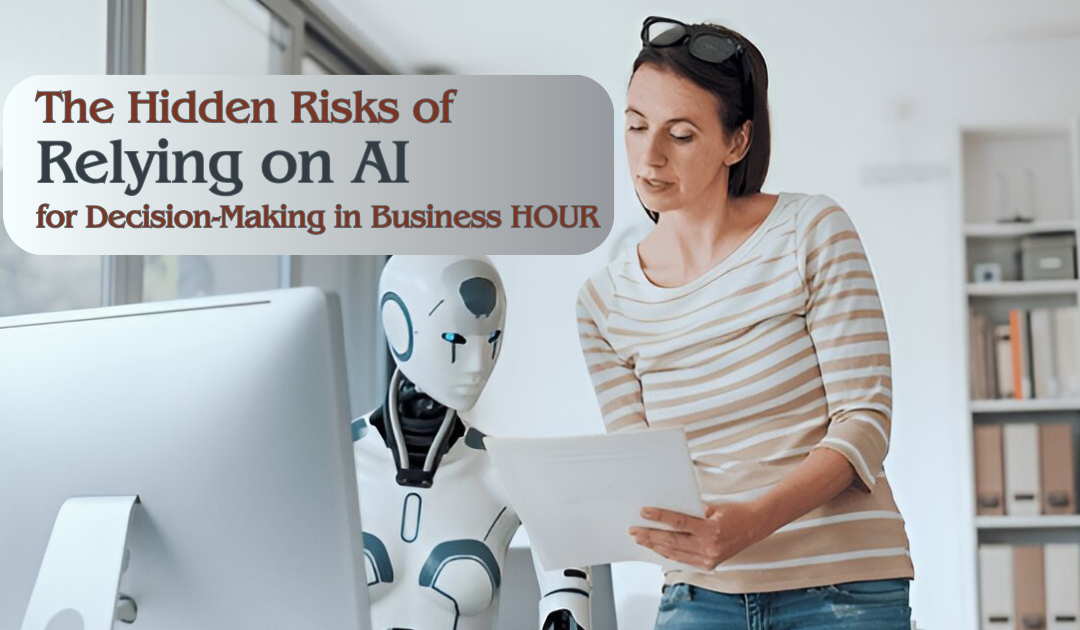Artificial Intelligence (AI) has emerged as a transformative tool in the business world, enabling companies to streamline operations, personalize customer experiences, and improve efficiency. Many businesses are now relying on AI to make critical decisions, from pricing strategies to supply chain management. While AI promises speed and data-driven accuracy, it also carries significant risks that may be less apparent. Understanding these hidden dangers is crucial for any business looking to integrate AI into its decision-making process.
1. Bias in Data and Algorithms
AI systems are only as good as the data they’re trained on. If the data fed into AI systems is biased, incomplete, or inaccurate, the outcomes will reflect those flaws. For instance, AI used in hiring processes may perpetuate biases present in historical data, leading to discriminatory hiring practices. Similarly, biased data can lead to unfair lending decisions, perpetuating systemic inequities in areas such as loans and credit. Companies may inadvertently make biased decisions without even realizing it, risking not only ethical breaches but also legal consequences.
2. Overreliance on Incomplete Data
AI thrives on large datasets, but not all business decisions have the luxury of complete, clean, and relevant data. In fields such as marketing or consumer behavior analysis, incomplete or ambiguous data is common. Relying solely on AI in these cases can lead to suboptimal decisions. For instance, in dynamic markets, Relying on AI algorithms may not account for sudden shifts in consumer behavior or unexpected disruptions (e.g., political events, natural disasters) because historical data may not capture these events effectively.
3. Lack of Human Intuition and Context
AI can process data and recognize patterns faster than any human, but it lacks emotional intelligence, intuition, and contextual awareness. In decision-making scenarios that require empathy, nuance, or ethical considerations, AI falls short. For example, customer service bots might make inappropriate recommendations because they cannot interpret emotional cues from frustrated customers. Human intuition, informed by experience, is essential in areas like leadership, crisis management, and relationship-building—areas where AI lacks the personal touch.
4. Challenges in Accountability
When decisions are made by AI, it can be difficult to pinpoint accountability if something goes wrong. Who is responsible when an AI-driven decision leads to financial loss, legal trouble, or ethical violations? AI systems, particularly those built on complex machine learning models, operate like black boxes, making it difficult to trace how they arrived at a particular conclusion. This lack of transparency can create confusion and risk, especially when decisions have legal or reputational implications.
5. Cybersecurity and Data Privacy Risks
AI systems rely on vast amounts of data, much of which may include sensitive customer or business information. This reliance opens up new vulnerabilities, as hackers can target AI systems to manipulate data, skew decision-making, or steal valuable information. Furthermore, privacy concerns arise when AI systems are not properly governed, risking violations of data protection laws like GDPR. Businesses that rely heavily on AI need robust cybersecurity measures in place to prevent breaches and safeguard data integrity.
6. Overconfidence and Automation Bias
Once companies begin to see success with AI, they may become overly confident in the technology’s abilities. This phenomenon, known as automation bias, occurs when people over-rely on automated systems, trusting AI’s decisions even when they might be incorrect. While AI can outperform humans in specific tasks, overconfidence in its capabilities can lead to poor decisions. For instance, traders using AI algorithms in financial markets may overlook critical macroeconomic factors that Relying on AI models fail to consider, leading to financial loss.
7. Limited Adaptability in Rapidly Changing Environments
AI algorithms depend heavily on past data to predict future outcomes. In fast-moving or highly unpredictable industries, AI may struggle to adapt quickly to new trends, unforeseen crises, or radical market changes. The COVID-19 pandemic was a prime example of how unexpected global events can disrupt AI models, as historical data failed to predict the rapid shifts in consumer behavior and market demand. Companies that rely on AI to make supply chain or product development decisions may find themselves unprepared when unforeseen changes arise.
8. The Cost of Maintenance and Upgrades
AI systems require constant updates, maintenance, and monitoring to ensure they remain effective and aligned with business goals. Models that worked well in one phase may need significant retraining or redesigning as market conditions or internal business strategies change. This can be a costly and time-consuming process. Furthermore, integrating AI into decision-making without proper foresight can lead to costly errors that outweigh the potential benefits, particularly in small or medium-sized businesses with limited budgets for AI infrastructure.
How to Mitigate These Risks
While Relying on AI offers many benefits, companies must take a balanced approach to AI integration. Here are a few steps to mitigate the hidden risks:
- Human Oversight: Ensure human oversight in decision-making processes where AI is used. This allows for human intuition and ethical considerations to complement AI-generated insights.
- Diverse and Unbiased Data: Take steps to address potential bias in data and ensure that training data is representative, diverse, and as complete as possible.
- Transparency and Accountability: Implement policies that clearly define accountability for AI-driven decisions and improve the transparency of AI models.
- Continuous Monitoring: Regularly monitor AI performance and reassess the algorithms as business conditions change to ensure decisions remain relevant and effective.
Conclusion
AI can be a powerful tool for businesses, but it is not without its risks. Bias, lack of intuition, overreliance, and security vulnerabilities are just some of the hidden dangers that businesses must navigate. By recognizing these risks and taking proactive measures to mitigate them, companies can harness AI’s potential while minimizing its pitfalls. For any business looking to stay competitive in an increasingly AI-driven landscape, a cautious and well-informed approach is key.












